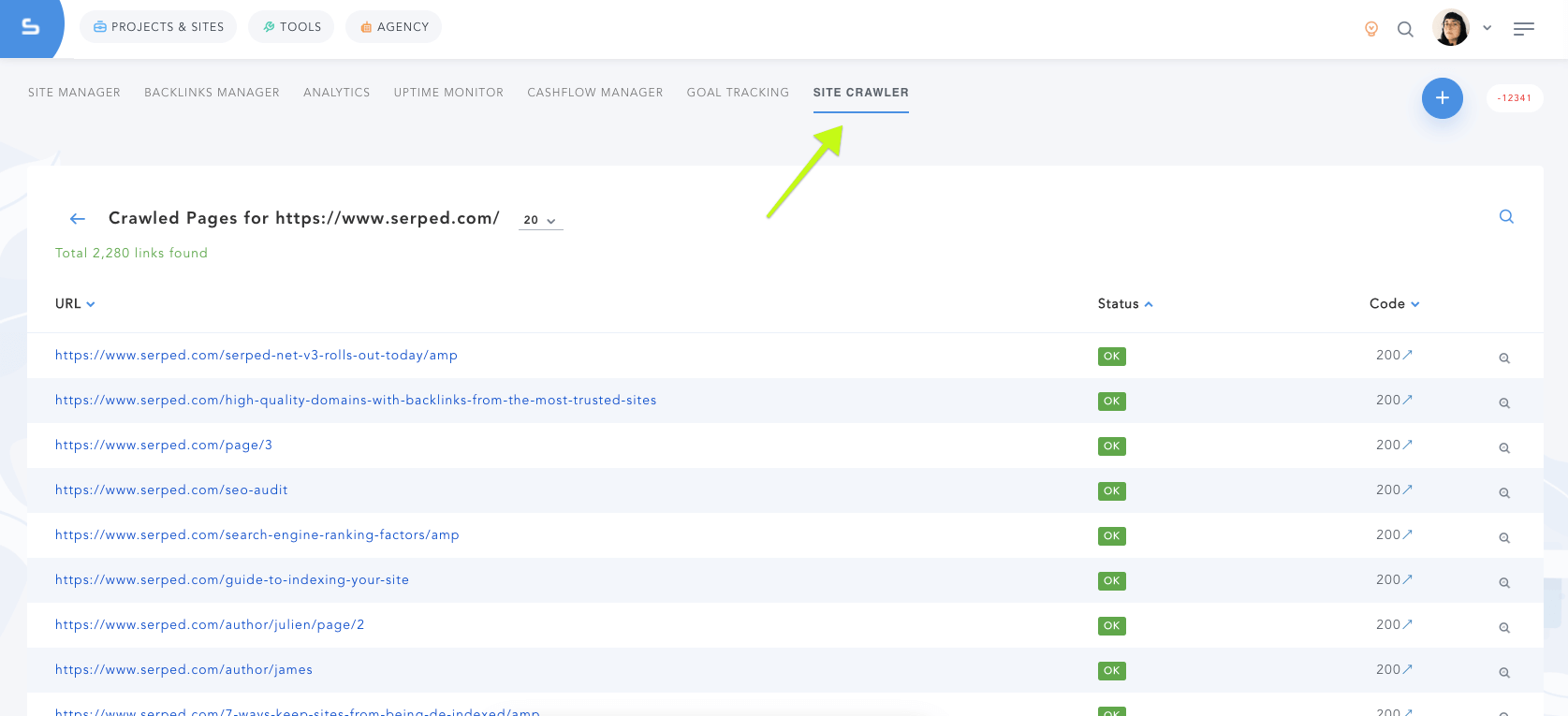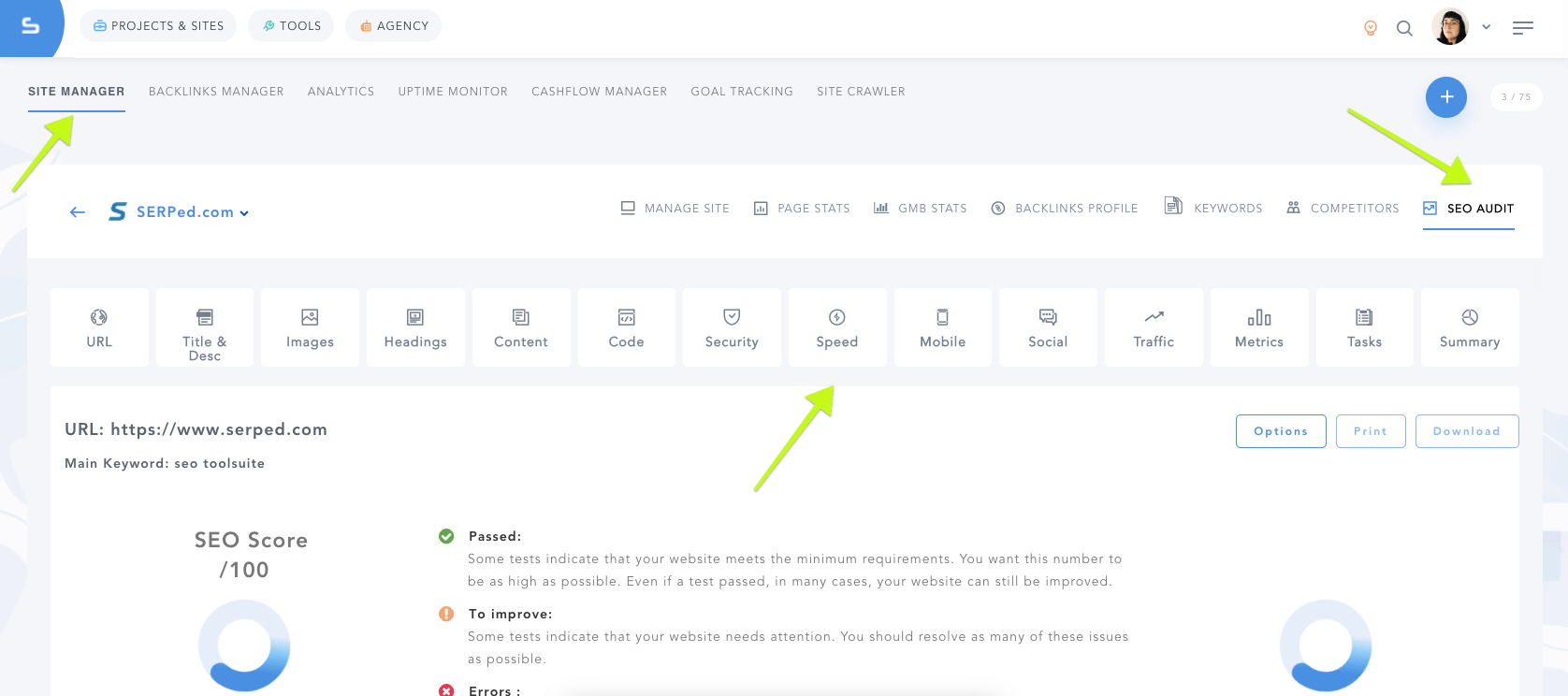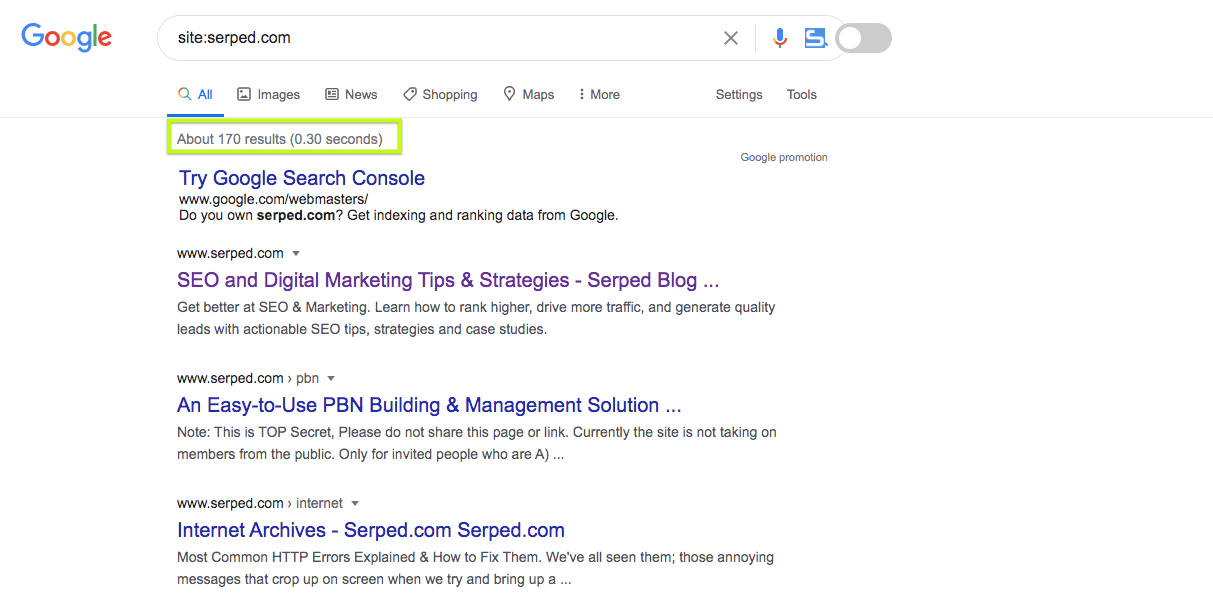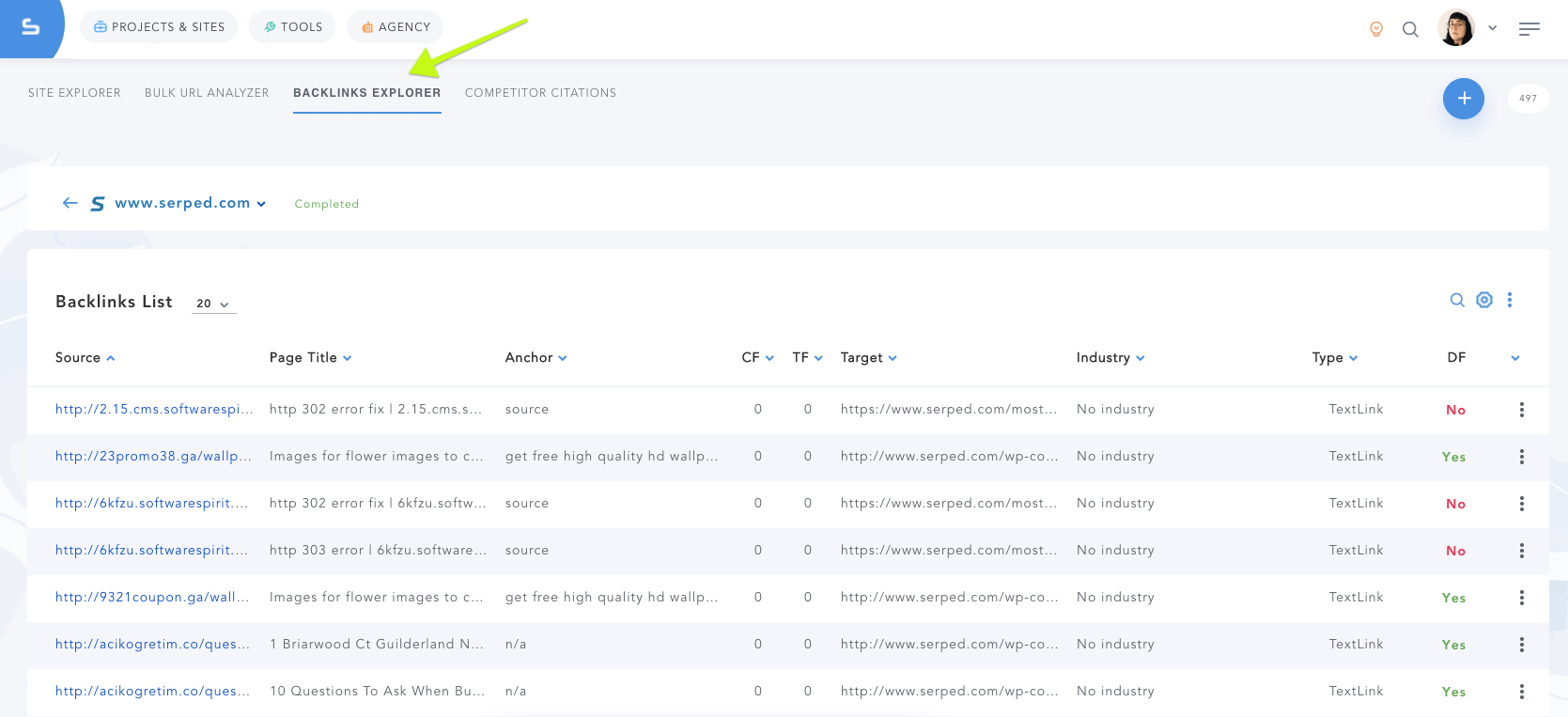When you first start SEO work on a website, there's a step that you can't skip: the SEO audit. Auditing can be a daunting task if you don't have the right tools – SERPed can make your life a lot easier with our SEO Audit tool, but it's always good to know how to do it the hard way.
The steps we're going to show you and the tips we'll give still apply even if you're using SERPed, as this article is going to give you a comprehensive breakdown of the SEO audit process. ?
We have divided this guide into six sections: accessibility, indexability, on-page SEO, off-page SEO, competitor analysis, and reporting. If you follow all the steps, you should be able to get quite a satisfactory audit for your website and your competitors'.
No matter if you're an SEO veteran or a beginner, the auditing process always raises questions. We strive to answer all those questions in this guide. If we missed something or you have any other questions, let us know in the comments section!
Table of Contents
1. Crawl Your Entire Website
This step is often ignored, but we believe it's quite important for a perfect SEO audit. You can choose any SEO tool available to crawl your website, but if you use SERPed, you just have to pick “Site Crawler” from the menu:

Crawling your website first will expose many issues that can provide you with an idea of what you need to change. You should also set up your crawler according to the search engine that your users are most likely to use – we recommend using Google. ?
On SERPed, you can add your project and your website and it'll crawl automatically.
2. Use Webmaster Tools
Webmaster Tools are available for most search engines. However, we recommend using Google Search Console. If you still haven't registered your website in this audit tool, now is a great time to do so.
Having your website on Google Search Console will help you immensely when it comes to understanding why certain pages of your website weren't crawled and any other possible SEO issues. It also helps improving performance on mobile devices. Pagespeed Insights are also a must have to check your load time.
3. Use Analytics
After getting all the information you can from the Search Console, we recommend using Google Analytics to get an understanding of how your users interact with your website. Analytics is a great audit tool that answers any question you might have regarding your traffic. That data will show you the most visited pages, how much time users spend on your website, your bounce rate… All these indicators are useful and will help you with your audit, not to mention they can be of use when improving user experience.
After these initial steps have been completed, let's move on to the actual SEO audit.
A. Accessibility
4. Check the robots.txt File
The goal of a robots.txt file is to prevent crawlers from accessing pages you want to keep private. However, this can result in blocking pages that should be crawled.
In this step, we recommend manually checking your robots.txt file so you can make sure you're not blocking any important area of your website and keeping it from being successfully crawled by search engines. Once you've found any pages that are blocked from crawlers that should be available, remove those URLs from the file and you're good to proceed.
5. Check the Robots Meta Tags
Robots meta tags define whether search engines can crawl specific pages and follow their links. When a page is blocked, you'll see the tag says <meta name=”robots” content=”noindex, nofollow” />. Remove this tag from any page where it might be erroneously placed.

6. Analyze HTTPS Status Codes
If there are URLs that return errors such as 4xx or 5xx, they will not be successfully crawled. Please check any pages that return those status codes when you crawl your website and make sure you forward those broken URLs to relevant pages. This kind of error is common, but it should always be taken care of.
Another thing to check at this stage is the redirects you're using. Make sure all your redirects use 301 HTTP; all other ways of redirecting, such as 302 HTTP, Javascript-based, and meta refresh are going to lose the “link juice” from the original page. By using 301 redirects, you are making sure that your deleted pages do not affect your ranking. ?
7. Analyze Your sitemap.xml File
Sitemaps make it easier for crawlers to get to all the pages on your website. Here are the factors you should consider when analyzing your sitemap:
- Is your sitemap correctly formatted as an XML file? Does it follow protocols? All sitemaps need to follow a specific format for them to be accepted. You can check this easily through Google Search Console.
- Are all pages that the Search Console crawled visible in your sitemap? You should make sure that your sitemap is up to date with all the pages you want to index.
- Are all pages in your sitemap visible in your crawl? If there are pages in your sitemap that do not show when you're crawling the website, those pages need to be re-linked to other areas of your website so they won't be orphaned – orphaned pages cannot be crawled. Make sure your sitemap list matches the crawled pages.
- Is your sitemap in your Search Console account? Uploading your sitemap on Search Console makes it easier for spiders to find it and use it as a roadmap to crawl your website faster. ?
8. Evaluate your Site Architecture
It is important to understand all the aspects of your site architecture. We recommend checking things like how many clicks does it take to get from the homepage to your most important pages so you can prioritize the most important pages on the website to make them easily accessible.
We recommend using a “flat” architecture to make sure you follow all linking opportunities, both vertically (site depth) and horizontally (the breadth of each level). This is quite an important factor when it comes to website elements.
9. JavaScript and Flash for Navigation
Some navigation techniques, such as JavaScript and Flash, are inaccessible to search engines. These days, crawlers have evolved quite a lot, but we still recommend avoiding Flash and JavaScript navigation altogether.
To understand if you're using JavaScript in places where you shouldn't be, we advise you to crawl your site twice – once with JavaScript disabled and then with it enabled. This will let you know if you're using JavaScript strictly for elements that need it or if it is affecting your website's crawlability. ?️
10. Page Speed
Your website's loading speed affects your users' experience, but it can also make it easier or harder for spiders to crawl your website. You can check your Page Speed on SERPed by clicking Site Manager > SEO Audit > Speed. ?♀️

We also recommend reading our article about page speed optimization.
B. Indexability
11. Use site: Command
If you make a search for site:yoursite.com, you'll find a rough estimate of the number of indexed pages for your website. In an ideal scenario, the number of indexed results in this search will be close to the number of pages in your manual crawl and in the sitemap.

However, there are two different issues that could arise during this process.. The first one is having significantly more pages indexed than the ones shown in your previous crawl. This means that your website might be serving duplicate content, which should be fixed.
If there are fewer pages indexed than the ones included in your sitemap by a large margin and you didn't find the reason why this was the case when you were crawling the site, then your website might have been penalized by the search engines.
If you think there might be duplicate pages indexed, simply add “&start=990” to your site:search. This should return a warning from the search engine mentioning that some results were omitted from the list because they were similar to the ones already shown. We'll talk about duplicate content later in this guide. ?️
12. Branded Keywords
Out of all the keywords that your website is trying to rank for, the most important is the name of your brand or company. Search for your brand name in your preferred search engine and check if your website is the first result. If it is, perfect. If not, you need to check if your website is being penalized for some reason.
13. How to Fix Search Engine Penalties
There are a few steps you should take to resolve any penalties your website might have incurred. The first one is making sure you've actually been penalized.
Most of the time, it's easy to find out if you've been penalized: you'll get a message in your Search Console, or your pages won't be indexed at all. So, make sure you have actually been penalized and that it is not just some search engine update that affected your rankings. Just like penalties, issues relating to search engine updates should be fixed as soon as possible.
If you receive a notification in Search Console, you'll already know why you've been penalized. If you didn't, look for search engine updates, especially on Google Webmaster Blog or other high authority SEO blogs. Some SEO forums are full of information, such as Warrior Forum. Search Engine Journal has a list of the types of penalties you can get and how to recover from them.
Then, you have to fix the behavior on your website that led to the penalty. Once again, SEO forums and blogs are your best source of ideas when it comes to resolving penalties.
The last step if you've been penalized is to request reconsideration from Google. This article in Google Support will show you how to submit a reconsideration request for this search engine. ⚙️
C. On-Page SEO
14. Analyze Your URLs
The first thing you should check in your on-page SEO is your URL. We have our own on-page SEO checklist you can refer to. There are a few quick rules you should follow when it comes to URLs:
- Use hyphens between words rather than underscores;
- Use subfolders rather than subdomains;
- Include your target keyword for each page in your URLs;
- Use static URLs rather than dynamic ones;
- Keep your URLs under 115 characters.
While you analyze the URLs for a whole website, there are also other questions you should ask yourself, such as how many URLs do not follow these best practices, if the errors are consistent, and if the domain uses the right keywords. We recommend using the most important keyword for the website in your domain name. ?

15. Check for Duplicate Content Through Your URLs
URLs can be the culprit for duplicate content. How? Well, if you have two URLs pointing to the same page, they're going to show up twice in indexed pages. Search engines treat each URL as unique content; if you have several URLs with the same content, search engines will dilute the “link juice” for that page.
These duplicate pages should have appeared in the crawl you performed at the beginning of this audit. However, you should check for duplicate URLs once again in this step.
16. Audit Your Content
To check your content easily, you can just view the cached version of your pages in Google. That version will be text-only, which makes it easier to audit your content. To audit your content thoroughly, follow these good practices:
- Your keywords should appear in the first paragraph of your content;
- Don't exaggerate your keyword usage (this is called keyword stuffing and it's highly detrimental to your rankings);
- Check your grammar and spelling (text with grammar and spelling errors makes you seem unprofessional);
- Use a readability metric such as Flesch-Kincaid to evaluate your content;
- Use a minimum of 300 words of content for each page;
- Avoid framing your content with extremely complex JavaScript or Flash, or adding text in your images (search engines need to be able to process your written content);
- Make your content valuable and appealing to your audience.
Other than these rules, there are three areas that you need to consider when evaluating your content:
- Does each page have a purpose inside the information architecture of your website? Does each important keyword have a dedicated page?
- Map your keyword usage so you can make sure that there is no keyword cannibalism. This happens when you have several pages trying to rank for the same keyword.
- Do you have several pages that use the same content? As you map your content, pick the pages you want to keep from the duplicate ones. You can use Copyscape to check for duplicates… ⌨️
17. Validate Your HTML
Your HTML is highly important for SEO as well. A lot of the on-page ranking factors are related to HTML. To check your HTML Markup (which will tell you if it matches the best standards for this coding language), you can use this validator.
18. Evaluate Your Titles
Your page titles will show up on search engine result pages, making it the first thing that users will notice while googling any subject. So, they should obey the following rules:
- Your keyword should be included, particularly at the beginning of your title;
- Keep your title under 70 characters;
- Make sure your title matches your content;
- Make sure each page has a unique title (you can check this on Search Console or during your crawl).
19. Analyze Your Meta Descriptions
To get a better click-through rate on your pages, you should make sure that your Meta Descriptions are optimized. The rules to follow are the same as the ones we mentioned for the titles: keep your meta descriptions succinct (under 155 characters) and relevant, and make sure your meta description perfectly describes your content. ?

20. Check Other Tags
Titles and Meta Descriptions are the two most relevant elements in your HTML <head>, but other tags deserve your attention as well. So, you should:
- Avoid meta keywords (they are often used by spammy websites);
- Use rel=”canonical” links only where necessary;
- If you use pagination series in some areas of your website, use rel=”next” and rel=”prev” to make it easier for search engines to handle pagination on your website.
21. Make Sure Your Images Are Optimized
For images to be perfectly read by search engines, you should make sure that you have the information they need in your alt tags and file names. Ideally, those parameters should include your keyword. ?
22. Use Outlinks Wisely
When you link to another website, you're implying that you endorse that other website's content and practices. Well, this should be done after careful consideration. We recommend only linking to high-authority websites; if your website links to spammy websites, there's a high chance it will be considered spam as well by search engines.
Also, make sure that the websites you're linking to are related to your content and relevant for your users. Doing so will improve your users' experience.
On another note, your anchor text should describe roughly what the linked page is about, and, ideally, include your keyword. Make sure you don't link to pages which return 4xx or 5xx errors since broken links affect your ranking.
Try not to use nofollow links, unless you cannot avoid it. We recommend making sure there are no unnecessary redirects in your links, especially if you're linking internally.
When it comes to internal linking, you should evaluate whether the pages that get the most links are the ones you want to prioritize. The most important pages on your website should have the most internal links. ↪️
23. Analyze your <body> Tags
Your <body> section should also follow a few rules:
- Place your keywords in your H1 tags;
- Avoid frames and iframes, since these are not going to be read as part of your page content;
- Avoid using too many ads. Make sure your ad-to-content ratio is reasonable.
D. Off-page SEO
24. Is your Website Popular?
Popularity is not everything, but it helps. To know if your website is popular, check these factors:
- Measure your popularity against competitors using ranking factors such as Alexa. This will help you understand if your website is more or less popular than your competition;
- Check if your traffic is increasing or decreasing using Google Analytics or Web Analytics on SERPed;
- Use measurements such as mozRank to find out your website's popularity and check your backlinks to see if your website is linked to or from popular websites.

25. Is Your Website Trustworthy?
There are several factors that can imply whether your website deserves the users' trust or not, the most important being occurrences of malware and spam.
To check for malware on your website, we recommend using Google Safe Browsing. To check if your website can be considered spammy, check if your website has any of these:
- keyword stuffing;
- hidden text with highly searched keywords that are unrelated to the website's subject;
- cloaking (showing something on search engines that does not match the content on your website).
If any of these can be found in your analysis, you should fix it as soon as possible. Neighboring sites also matter: if you receive links from websites that aren't trustworthy for some reason, disavow those links immediately.
26. Draw Your Backlink Profile
If you use SERPed, it's easy to analyze your backlinks. Your backlink profile analyzes the quality of the websites that link to your website and gives you tips on possible improvements. To check your backlinks on SERPed, use the Backlinks Explorer tool. ✈️

Now that you have your backlink list, ask yourself these questions to draw your profile:
- How many of your backlinks are nofollow? You should strive to keep a balance since too many nofollow links are damaging to your SEO profile, but remember having zero nofollow links will seem suspicious for search engines.
- Is your anchor text fitting, or are you using it for keyword stuffing? If you use the same anchor text a lot on your website, search engines might consider those links spam.
- Are the websites linking to you relevant for your website's subject? Relevant backlinks help you establish your reputation online.
- Are there too many links from the same domain? It's better to have a higher percentage of backlinks from different domains than having a very low domain variety in your backlinks, even if the same domain has linked to you a hundred times.
- Are the websites linking to your domain popular and trustworthy? Trust and popularity follow the same rule as spam: if you get too many links from low-quality domains, your website may be considered to be of low quality as well.
27. Evaluate Your Authority
The most commonly used metrics to check the authority of your website are Page Authority and Domain Authority from Moz. You can access those metrics in the “Site Explorer” area on SERPed.

These metrics predict how well a page or domain is going to perform in search engine results pages. Obviously, Domain Authority predicts it for a whole domain, whereas Page Authority does the same for each page in a domain. ?
28. Check Social Engagement
The web has become increasingly social in the last few years. This means that social media has an influence on your website's popularity.
You should check how many shares, likes, and retweets your website is getting, and understand how popular your website is on social media. It helps to have social sharing buttons on every page of your website. You can use Shared Count to check how many times your website's pages were shared.
E. Competitor Analysis
29. Perform an SEO Audit on Your Competition
After completing all these tasks, you have to do it all over again for your competitors' websites. This will give you insights into what you have to improve sooner rather than later. It might seem like too much effort to go through all we have mentioned again for each main competitor, but we would recommend doing it.
Knowing where each of your competitors stands when it comes to SEO will help you mirror their best strategies when implementing changes on your website.
F. Reporting
30. Main Considerations When Writing Your Report
When you have to show your conclusions to someone else on your SEO audit, there are a few things you should take into account:
- Sometimes, not everyone who will read your report will have technical SEO knowledge. So, you should strive to make your report easy to understand for anyone who's going to read it.
- Remember that everyone's time is limited. Make sure to put the most pressing issues at the beginning of your report. If anything does not need to be fixed urgently, you can even keep it out of the report or just mention it towards the end of it.
- When advising about the next steps, be concise and to the point. Don't give generic advice; use actionable steps that can be easily implemented. Of course, you can't provide new titles and meta descriptions for every single page that needs to be optimized, but you should at least be able to come up with a few for the most important pages.
SEO Audit in SERPed.net
We recently launched a new SEO Audit tool, available for all SERPed.net members, at no extra cost. This tool allows you to perform an audit for any website: no matter if it's your website, a client's, a prospect's or even a competitor's.
Using our SEO Audit tool, you can generate a one-off report, or automate a report which will be scheduled according to your needs. You can ask for a report to be generated every week, every month, or every quarter, and you can also define the weekday in which the report will be sent.
On the report, you'll find metrics such as the SEO Score, Speed Score on Desktop, Speed Score on Mobile, MozRank, Domain Authority and Page Authority. You'll also get a graph so you can track the progress of the sites over time.
Wrapping Up
These are our tips for a thorough SEO audit. If you use SERPed, you'll find our SEO Audit function covers a lot of what you need to do, but it's always useful to know how to do it the “old-fashioned way”. Using our tips, you can complement your SERPed SEO audit info with a few extra bits that will help you go further in your implementation.
If you need help with your SEO audit, or you have any tips that we didn't mention in this guide, let us know in the comments!


